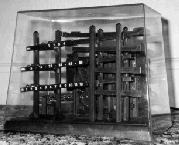Not an official ACM page
[Problem C
| 1995 ACM finals problem set
| My ACM problem archive
| my home page]
1995 ACM Scholastic Programming Contest Finals
sponsored by Microsoft ®
Problem B
Tempus et mobilius
Time and motion

Tempus est mensura motus rerum mobilium.
Time is the measure of movement.
--Auctoritates Aristotelis
...and movement has long been used to measure time. For example, the
ball clock is a simple device which keeps track of the passing minutes
by moving ball-bearings. Each minute, a rotating arm removes a ball
bearing from the queue at the bottom, raises it to the top of the
clock and deposits it on a track leading to indicators displaying
minutes, five-minutes and hours. These indicators display the time
between 1:00 and 12:59, but without 'a.m.' or 'p.m.' indicators. Thus
2 balls in the minute indicator, 6 balls in the five-minute indicator
and 5 balls in the hour indicator displays the time 5:32.
Unfortunately, most commercially available ball clocks do not
incorporate a date indication, although this would be simple to do
with the addition of further carry and indicator tracks. However, all
is not lost! As the balls migrate through the mechanism of the clock,
they change their relative ordering in a predictable way. Careful
study of these orderings will therefore yield the time elapsed since
the clock had some specific ordering. The length of time which can be
measured is limited because the orderings of the balls eventually
begin to repeat. Your program must compute the time before
repetition, which varies according to the total number of balls
present.
Operation of the Ball Clock
Every minute, the least recently used ball is removed from the queue
of balls at the bottom of the clock, elevated, then deposited on the
minute indicator track, which is able to hold four balls. When a fifth
ball rolls on to the minute indicator track, its weight causes the
track to tilt. The four balls already on the track run back down to
join the queue of balls waiting at the bottom in reverse order of
their original addition to the minutes track. The fifth ball, which
caused the tilt, rolls on down to the five-minute indicator
track. This track holds eleven balls. The twelfth ball carried over
from the minutes causes the five-minute track to tilt, returning the
eleven balls to the queue, again in reverse order of their
addition. The twelfth ball rolls down to the hour indicator. The hour
indicator also holds eleven balls, but has one extra fixed ball which
is always present so that counting the balls in the hour indicator
will yield an hour in the range one to twelve. The twelfth ball
carried over from the five-minute indicator causes the hour indicator
to tilt, returning the eleven free balls to the queue, in reverse
order, before the twelfth ball itself also returns to the queue.
Input
The input defines a succession of ball clocks. Each clock operates as
described above. The clocks differ only in the number of balls present
in the queue at one o'clock when all the clocks start. This number is
given for each clock, one per line and does not include the fixed ball
on the hours indicator. Valid numbers are in the range 27 to 127. A
zero signifies the end of input. Output For each clock described in
the input, your program should report the number of balls given in the
input and the number of days (24-hour periods) which elapse before the
clock returns to its initial ordering.
Sample Input
30
45
0
Output for the Sample Input
30 balls cycle after 15 days.
45 balls cycle after 378 days.
This page maintained by
Ed Karrels.
Last updated September 20, 1999
